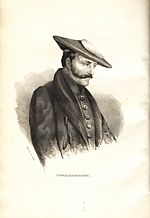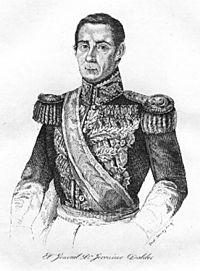Lord Eliot Convention facts for kids
The Lord Eliot Convention, also called the Eliot Convention or Eliot Treaty (Spanish: Convenio Lord Eliot), was an important agreement made in April 1835. It was arranged by Edward Eliot, 3rd Earl of St Germans, a British diplomat. The agreement was between the two sides fighting in the First Carlist War in Spain.
The main goal of the convention was not to end the war itself. Instead, it aimed to stop the cruel practice of executing prisoners by firing squad. Both sides in the war had been doing this without much thought or trial. Edward Eliot had become a British diplomat in Madrid in 1821 and was known as Lord Eliot from 1826.
Contents
Why the Convention Was Needed: Stopping Executions
During the First Carlist War, which started in 1833, many prisoners were executed. Carlist prisoners who did not accept Queen Isabel II as their ruler were often shot.
One of the first executions by Isabeline forces was of Santos Ladrón de Cegama in October 1833. Later, in December 1833, Vicente Genaro de Quesada, a general, ordered five Carlists to be shot. Prisoners were given only a few hours to prepare for death. The archbishop of Burgos asked for more time for prisoners, but Quesada said it wouldn't make a difference.
The Carlists, who were often weaker, also started executing their prisoners. They did this partly as revenge and partly because they didn't have good places to keep prisoners. For example, if they were fighting in the mountains, they couldn't take prisoners with them. So, they would execute them before moving. After the Battle of Alegría de Álava in October 1834, Liberal soldiers found hiding were shot immediately. The Liberal commander, Manuel O'Doyle, was also executed.
A well-known event was when the Carlist general Tomás de Zumalacárregui ordered the execution of 118 Isabeline prisoners at Heredia.
Espartero, an Isabeline general, complained about these brutal executions. He believed the government should set rules for how prisoners were treated, just like rules between two different countries in a war.
Britain Steps In to Help
The British government became concerned about the violence. They decided to send a special team to Spain. This team's job was to help both sides agree to stop the executions. Lord Eliot and Colonel John Gurwood led this mission.
One historian wrote that "the killing of prisoners had happened many times, and both sides were full of hate and revenge." The war was so savage that the Duke of Wellington, a famous British general, sent Lord Eliot and Colonel Gurwood to Spain. Their goal was to try and stop the cruel acts and make the war less bloody.
Both Eliot and Gurwood spoke excellent French and Spanish. They were well-prepared for their mission. Lord Eliot was described as a polite and gentle man, 34 years old. Colonel Gurwood, who wore a uniform, joined him as his secretary.
Eliot and Gurwood Arrive in Spain
Lord Eliot arrived in Bayonne, France, on April 5, 1835. He quickly contacted Francisco Espoz y Mina, the main general of the Isabeline forces in Pamplona. Lord Eliot told Espoz y Mina that he also wanted to speak with Don Carlos, the Carlist leader. He asked that Isabeline forces not stop him.
Espoz y Mina sent a British observer named Wilde to escort Eliot and Gurwood into Spain. On the way, Wilde met with the Carlist general Zumalacárregui and had dinner with him on April 20, 1835. This gave Wilde a chance to tell Zumalacárregui about Eliot, Gurwood, and their mission.
Eliot and Gurwood reached Segura on April 20, 1835, and met with Don Carlos. Don Carlos sent them to Zumalacárregui, who would negotiate the agreement. Eliot and Gurwood left Segura on April 23 and arrived at Alsasua, escorted by a Carlist colonel.
The Agreement Is Signed
Around this time, the battle of Artaza (April 20–22, 1835) had just ended. Isabeline troops under Gerónimo Valdés were defeated and took shelter in Estella.
Zumalacárregui met Lord Eliot in the valley of Berrueza. Zumalacárregui quickly agreed to the convention. He signed it on April 24 in Asarta. This act saved the lives of 27 Isabeline prisoners who were about to be executed.
Lord Eliot wanted Zumalacárregui's autograph. The Carlist general wrote about their meeting on April 25, 1835. As a gift, Lord Eliot gave Zumalacárregui a telescope that Wellington had used during the War of Spanish Independence. This telescope is now kept in a museum in Madrid.
The British team traveled with Zumalacárregui from Asarta to Estella. They were looking for the Isabeline general Gerónimo Valdés to get him to sign the agreement. Valdés was now in charge of operations in northern Spain. On their way, they stopped at a convent in Irache. Zumalacárregui joked about the "beautiful nuns" there who made "excellent chocolate."
Eliot did not find Valdés in Estella but found him in Logroño. Valdés was not completely happy with the text Zumalacárregui had signed. He made some changes he thought were necessary. He signed the agreement in Logroño on April 27, 1835. A Carlist colonel took the new text back to Zumalacárregui, who signed the updated agreement on April 28, 1835, in Eulate.
The Lord Eliot Convention had nine main points:
- 1. Protect the lives of prisoners.
- 2. Regularly exchange prisoners.
- 3. Exchange an equal number of prisoners.
- 4. Exchange prisoners based on their military rank.
- 5. Respect the towns chosen for holding prisoners.
- 6. Political prisoners must be tried fairly by law.
- 7. Respect sick and wounded soldiers.
- 8. The agreement applies to all parts of Spain.
- 9. Strictly follow the convention.
Article Six was very clear:
During this war, no person, whether a civilian or a soldier, should be killed because of their political beliefs. They must first have a fair trial and be found guilty according to the laws of Spain. This rule applies to those who are not actual prisoners of war. For prisoners of war, the rules in the other articles apply.
What Happened After: The Convention's Impact
The Lord Eliot Convention helped set rules for how prisoners were treated in the First Carlist War. Its positive effects were seen right away. A soldier from the British Legion wrote:
The British and Chapelgorris (a type of soldier) who were captured by the Carlists were often killed without mercy, sometimes with torture. But Spanish regular troops were saved because of the Eliot treaty. After being held in prison, where they were treated roughly, they were often exchanged for an equal number of prisoners taken by the Christinos (Isabeline forces).
Charles Frederick Henningsen, who fought with the Carlists, dedicated his book, Twelve Months' Campaign with Zumalacárregui, to Lord Eliot. He praised Lord Eliot for bringing blessings to the people of Spain.
However, even though both sides agreed to treat prisoners fairly, the cruel acts started again after only a few months.
Images for kids
See also
 In Spanish: Convenio Lord Eliot para niños
In Spanish: Convenio Lord Eliot para niños





